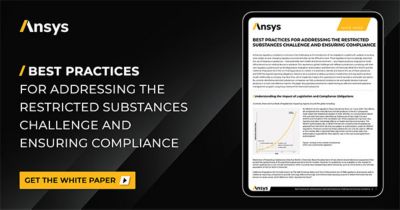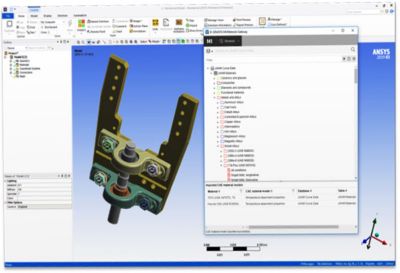ANSYS BLOG
March 31, 2021
Design with Compliance in Mind: How to Build Compliance Into Your Product Development Process
When a product is created, the decisions that underlie its development are well documented and oftentimes marketed as a part of its appeal or functionality. Innovation is a concept inherent to design, and it is typically dependent upon a deep level of understanding about a problem and how industry can address it in effective and unique ways. What is typically excluded from this design process are concerns about market forces unrelated to functionality and feasibility. These forces are often unanticipated, like supply chain disruptions or consumer behavior, and can lead to major issues in terms of the ability to create and sell a product.
A force that is completely outside of most organizations’ control is the changing legislative initiatives across the globe. Government bodies around the world often create or modify legislation that restrict the substances and materials that can be bought and sold in their region. Organizations often lack adequate contingency plans for this ever-changing regulatory environment. To address this problem, the product development process must be examined with a critical lens to assess where and how compliance can fit into processes that already exist.
Consider Compliance Early and Often
To facilitate this discussion, let’s look at a generic product development process where there are five main steps to bringing a product to market:
1) Product ideation
2) Product design
3) Completion of simulation and prototyping
4) Calculation of product compliance
5) Manufacture and selling of product
At each stage of this process, the costs associated with a major change increase, as does the effort required to rectify a change. These changes are sometimes accounted for, as design is always an iterative process and critical examinations of each phase are important to making the best product. Often these examinations are focused on product performance. The essence of the product development process resides in making the best, most efficient product that you can within the limits of an engineering and design space.
There is a fundamental flaw with this approach: By the time compliance is considered, the design process is mostly complete. Changes that are necessary to solve any compliance problems discovered late in product development are expensive and time-consuming because they require revisiting extensively justified and verified design decisions. To solve this issue, we can look to design with compliance in mind by moving the fourth stage of the compliance assessment process across the first three and examine ways to future-proof this critical part of the process.
A workflow that brings compliance assessment upfront in the product design and development process saves time and money while providing future accountability.
Weave the Digital Thread Through Product Design and Development
The ideation stage of product development is usually unconstrained with thoughts beyond what is possible for a product and what can be can be built based upon what already exists. In some cases, there is little-to-no framework for what is possible, and products are developed based on an idea or mindset inherent to the group.
We can begin to move compliance into this part of the design process by simply giving industrial and product designers the tools to understand their materials options, not only the aesthetics, color or feel, but also simple indicators as to their recyclability, compliance status or carbon footprint. Having these thoughts as part of the ideation process starts the product development process with the concept of compliance in mind, and lets other decisions carry these ideas forward.
An easy way to get the designers to consider compliance in the product design stage is to let their material choices be dictated by what materials are compliant. Ansys Granta MI can let members of a compliance or materials team select and differentiate materials as being compliant (or sustainable) directly within a designer’s native computer-aided design (CAD) tools. This accessibility and ease of incorporation enable designers to select a material knowing its desired properties, with confidence that the material chosen is compliant and sustainable.
The decisions made by the design team directly influence the materials used in the simulation and prototyping stage. By having compliance in the design process, we can ensure that these decisions are communicated downstream to the simulation analysts.
Ansys Granta MI enables users to determine which materials are compliant.
An added benefit to adding materials intelligence to these workflows is that any tweaks or changes necessary to complete a product’s development can be informed by the same tools used by designers. The direct integration that exists between Granta and finite element analysis (FEA) tools enables material access to be restricted to only “Approved” ones, and bring the parameters necessary for analysis directly into their workspaces.
In this updated workflow, the digital thread has been built through each stage of the process and materials have been assigned with this traceability in mind. Calculating compliance is easy and effective because the materials and their constitutive substances have already been mapped and tracked so tools like Granta’s BoM Analyzer can visually assess a product’s compliance. The bill of materials (BoM) created in design tools can be brought directly into Granta, and information can be tracked automatically, not manually through spreadsheets.
Granta MI can help to future-proof this process by inherently enabling new substances to be tied to materials that are already used in products. These substances constantly change, but Granta tracks them and allows for a quick assessment as to how modifications to legislation can impact products that already exist or are being developed. Thus, mitigating the risk of potential product recalls ensuring brand perception is safeguarded.
Ansys Granta features direct integration to design tools.
By democratizing compliance and considering it across the product development process, it’s easy to see how organizations can speed up and future-proof the important step of calculating product compliance.
For more information, download the Best Practices for Addressing the Restricted Substances Challenge and Ensuring Compliance white paper.



